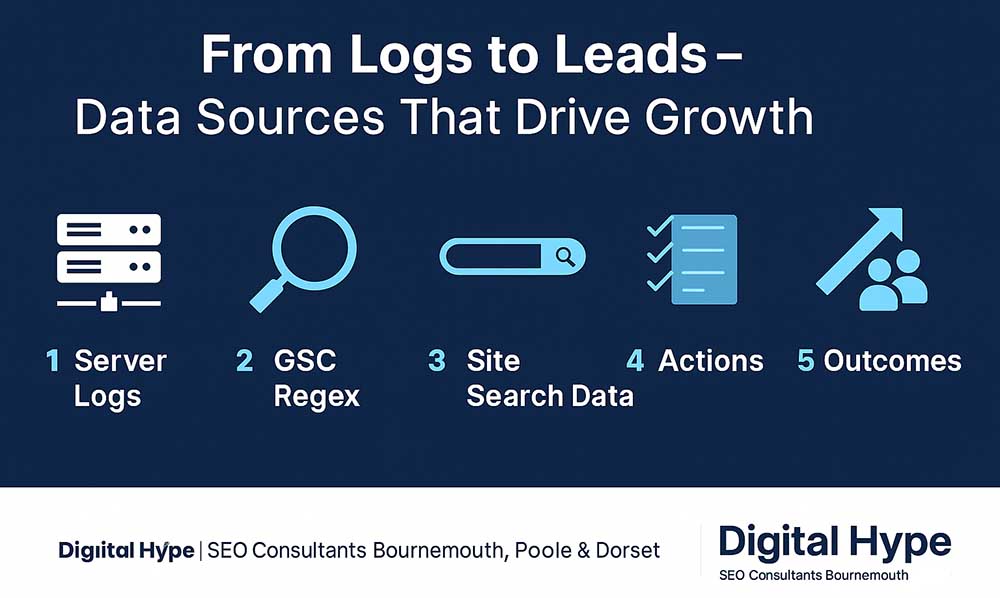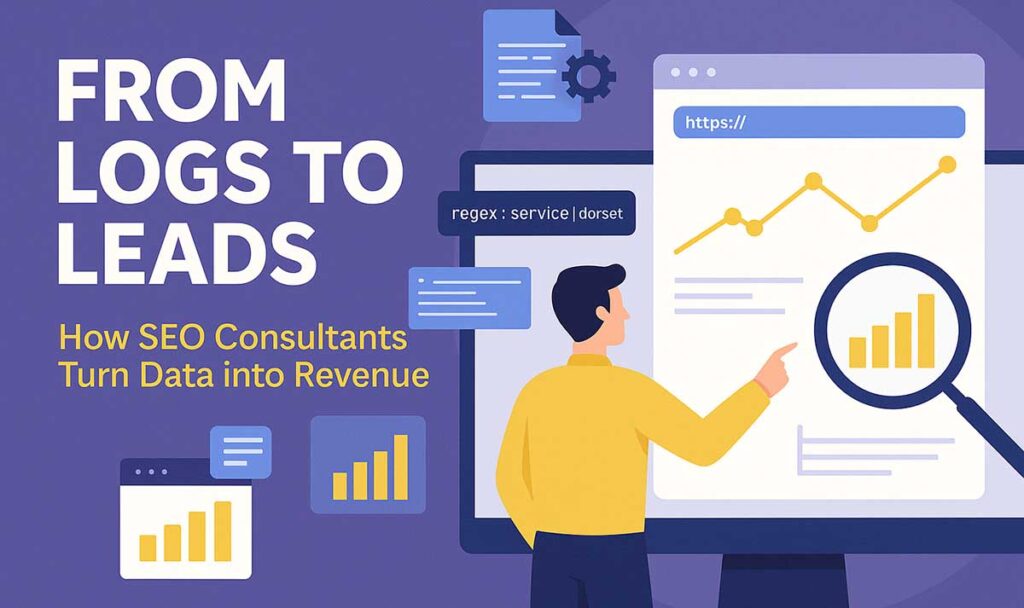I’ll let you in on a trade secret. The most profitable keyword list I ever found for a Bournemouth client didn’t come from SEMrush or Ahrefs. It came from their server logs. Buried in those endless lines of code were the queries and crawl patterns Googlebot cared about — and the customers were hinting at. Pair that with some regex in Google Search Console and a peek at their site search data, and we unlocked a stream of buyers they didn’t even know existed.
This is what separates SEO consultants in Bournemouth from “checklist SEO.” We’re not just chasing rankings. We’re reading the signals hidden in your data to uncover intent, cut waste, and turn forgotten corners of your site into revenue drivers.
Why standard keyword lists miss the money
Most businesses across Bournemouth and the UK I’ve audited rely on one thing: exported keyword lists. The problem? They’re static, surface-level, and often biased towards head terms. They miss:
- Crawl waste — Googlebot is consuming resources, such as filters, search results pages, or dead content.
- Long-tail regex patterns — queries like “buy [service] in Poole today” that GSC won’t group neatly.
- Customer intent inside site search — what visitors actually type once they land.
Without looking at these, you’re leaving traffic and money on the table.
Triage table: signals, fixes, and ROI
| Signal (where) | Likely Cause | Action | Effort | Expected Impact | Check After |
| High hits to 404s (logs) | Legacy URLs | Map clusters → 301 redirects | S | Crawl efficiency, CTR recovery | 14 days |
| Crawl spikes on faceted URLs (logs) | Infinite filters | Disallow facets, canonicals | M | Crawl budget return, index control | 21 days |
| Regex queries with low CTR (GSC) | Title/intro mismatch | Reframe titles + first 100 words | S | +2–5% CTR | 21 days |
| Long-tail regex with conversions (GSC) | Unoptimised pages | Create intent-fit landing pages | M | New lead streams | 30 days |
| Site search for “pricing” (analytics) | Poor pricing visibility | Add pricing page & nav links | M | Higher conversion rate | 30 days |
| Site search exits on “returns” | Policy hidden | Add clear returns/process content | S | Reduced drop-offs | 14 days |
Turning noise into opportunity
When I worked with a Dorset e-commerce retailer, we spotted thousands of log hits to a discontinued product line. Instead of letting Googlebot waste crawl budget, we redirected clusters to the new equivalent products. Within two months, those redirects became their third-biggest revenue source.
For a Poole service firm, regex queries in GSC revealed buyers were searching for “same day” and “urgent.” None of their copy used those words. We rewrote their service page headers and CTAs. Enquiries jumped by 27%.
For a Bournemouth SaaS client, internal site search revealed hundreds of queries for “integration with X.” This led to the creation of a comparison hub. Today, it’s their highest-converting content asset.
That’s the power of data beyond the keyword list.
Want to Improve Your SEO Rankings?
Strong SEO means more visibility, more traffic, and more customers. At Digital Hype, we specialise in helping businesses across Bournemouth, Poole, Dorset and the UK-wide climb Google rankings with strategies that actually deliver results. Let’s build an SEO plan that grows your business for the long term.
Contact Our SEO ExpertsWhat to do this week

- Export your server logs (even 30 days is enough).
- Spot clusters of 404s and redirect them correctly.
- Run regex filters in Google Search Console for terms like “near me,” “today,” “cheap,”and “best.”
- Pull your site search data — list the top 10 internal queries.
- Ask: are those words visible in titles, H1s, or CTAs?
- Prioritise one fix (redirects, copy update, new landing page).
- Measure after 30 days: crawl activity, CTR, conversions.
Smart FAQ: data-driven keyword discovery
1. Why bother with server logs?
They reveal where Googlebot spends its crawl budget and where customers try (and fail) to land.
What to do: Map clusters and redirect waste.
Metric to watch: crawl efficiency in Search Console.
2. When does regex beat filters in GSC?
When queries are messy (e.g., “buy service in Dorset today”). Regex groups them into patterns you can act on.
What to do: set up saved regex filters.
Metric to watch: CTR shifts after page tweaks.
3. How can site search improve SEO?
It shows customer demand in their own words. If they type “pricing” or “returns,” your site isn’t clear enough.
What to do: surface content early.
Metric to watch: reduced search exits.
4. What if logs show crawl waste on filters?
You’re bleeding budget.
What to do: block facets, add canonicals, simplify nav.
Metric to watch: index coverage reports.
5. How do I prioritise fixes without dev time?
Redirects and content rewrites first — quick wins. Technical fixes later.
What to do: rank actions by ROI vs effort.
Metric to watch: conversions from new/redirected pages.
6. Do I need expensive tools for this?
Not always. Basic log exports + GSC regex + GA site search can reveal 80% of the wins.
What to do: start simple, scale tools as needed.
Metric to watch: qualified lead growth.
7. Can this approach help small Dorset firms?
Yes. Even a plumber’s site search (“boiler service today”) can uncover profitable terms.
What to do: check the internal search weekly.
Metric to watch: calls from updated service pages.
Where Growth Actually Starts
Anyone can pull a keyword list. But real consultants read between the lines — the logs, the regex, the search boxes. That’s where intent lives. That’s where waste hides. And that’s where the growth starts.
👉 Book a free SEO audit today or explore our wider SEO services to see how we approach search strategy from the ground up.


